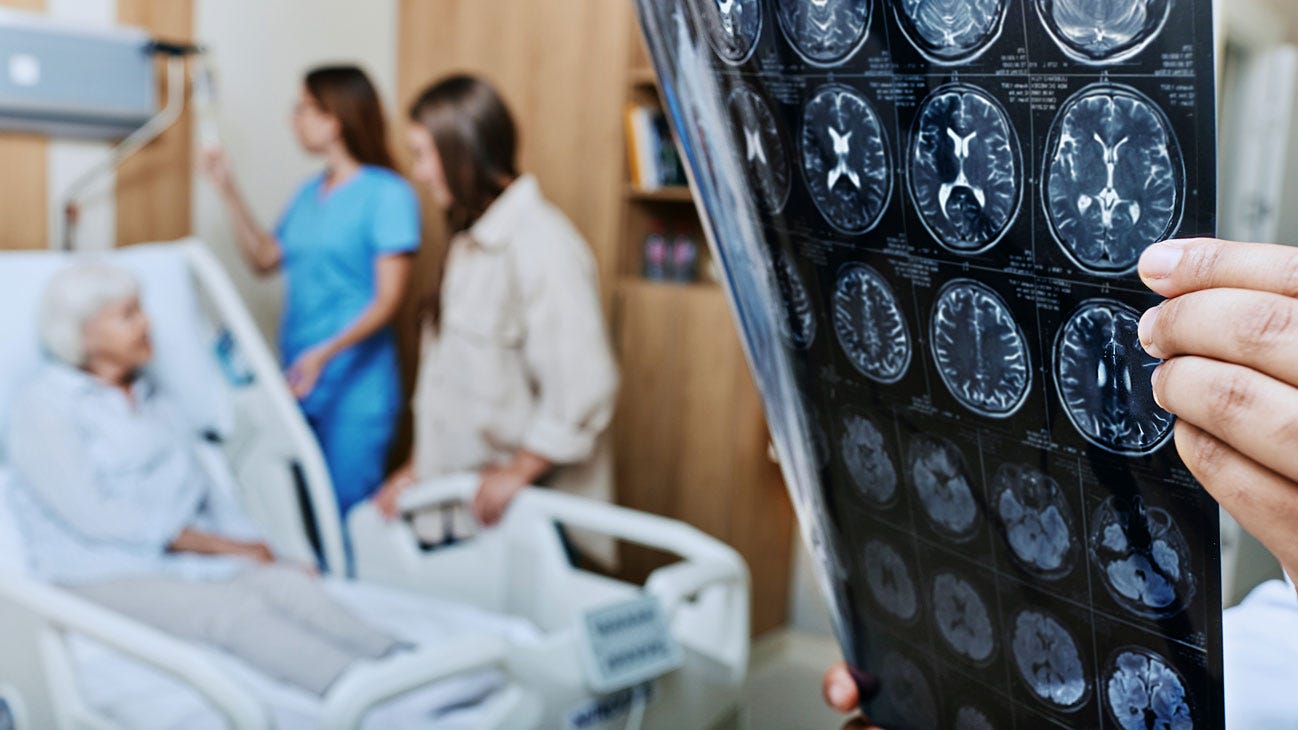Brain haemorrhage: and suddenly everything changes
Brain haemorrhage is a silent assailant that changes lives within seconds. Older people are particularly affected – but young people can also be affected.

It happens suddenly, often without any warning – a small blood vessel in the head bursts. Blood that normally keeps the body alive becomes a dangerous assailant, making its way through the brain. Every year, 2,000 to 3,000 people suffer a brain haemorrhage in Switzerland alone. More than 80% of these incidents occur out of nowhere. Those affected often feel no pain beforehand and cannot identify any warning signals. But within a few seconds, their life changes – in the worst case, it even comes to an end.
Causes: high blood pressure is the biggest risk factor for brain haemorrhages
The causes of a cerebral haemorrhage are manifold. For example, chronic pre-existing conditions such as high blood pressure or arteriosclerosis can cause the walls of the blood vessels to become weak and susceptible to rupture. The word cerebral haemorrhage is therefore an umbrella term that covers various syndromes. Doctors distinguish between several forms of bleeding within the skull:
-
Intracerebral haemorrhage
An intracerebral haemorrhage is when blood enters the brain. This can be caused by high blood pressure in combination with arteriosclerosis, as a result of which a blood vessel in the brain ruptures and causes bleeding in the brain tissue.
-
Subarachnoid haemorrhage
A subarachnoid haemorrhage occurs below the middle membrane covering of the brain and can result in a stroke. It is estimated that around 5% of all strokes are caused by a subarachnoid haemorrhage.
-
Epidural haemorrhage
In an epidural haemorrhage, blood accumulates over the tough outer membrane covering the brain. The most common cause of this type of brain haemorrhage is a traumatic impact from outside – for example, an accident.
-
Subdural haemorrhage
In a subdural haemorrhage, blood accumulates underneath the tough outer membrane covering the brain. Usually, this type of haemorrhage is triggered by an external force, such as the impact of the head during a fall, which causes blood vessels to rupture.
One risk factor in particular for intracerebral haemorrhage is age. According to the Swiss Cerebrovascular Registry, brain haemorrhage patients are on average 72 years old and male in 55% of cases.
However, the most important risk factor for a cerebral haemorrhage is long-standing high blood pressure, explains Prof. Nils Peters, specialist in neurology and medical director of the Stroke Center at the Hirslanden Clinic Zurich. The prolonged stress that high blood pressure exerts on the small vessels of the brain can weaken them and make them vulnerable. If blood pressure rises abruptly, a weakened artery can burst, opening the way for blood to flow to the brain.
This makes it all the more important to control blood pressure well in the long term and, if necessary, to adjust it with medication. Certain medications, especially blood thinners, can also influence the severity of a brain haemorrhage. If an artery ruptures and the blood is thinner than normal, the bleeding can last longer and spread more quickly. “That’s why it’s important that people who take blood thinners only do so for a valid reason, especially such as suffering from high blood pressure,” continues Peters.
Symptoms: from visual problems to signs of paralysis
The symptoms of a brain haemorrhage vary depending on the type, location and extent of the haemorrhage. What all forms of brain haemorrhage have in common, however, is that they must be treated urgently. Neurologist Nils Peters advises contacting an emergency doctor immediately or going to the nearest stroke centre or stroke unit if you notice one or more of the following symptoms:
- Sudden attack of weakness or paralysis on one side of the body
- Sudden numbness on one side of the body
- Speech or language disorders
- Vision problems such as double vision, blurred vision, temporary loss of vision in one eye or loss of visual field on one side
- Dilated pupils
- Dizziness, unsteadiness when walking, balance or coordination problems
- Sudden onset of a severe headache, possibly with nausea and vomiting
- Sudden change in consciousness, from confusion and drowsiness to unconsciousness and coma
Treatment: every minute counts
In the centre’s emergency room, the first step is to ensure that the patient’s vital signs are stable. “This is followed by a quick neurological examination to assess the symptoms and determine the severity of the disease,” explains Nils Peters. In addition, blood pressure is quickly checked and it is determined whether there is any blood thinning. This is followed by an imaging examination of the brain, usually a computer tomography, to immediately determine whether it is actually a cerebral haemorrhage or rather a circulatory disorder of the brain (ischaemic stroke).
“In this case, it’s important to reduce any increase in blood pressure as quickly as possible with medication in order to stop the progression of the haemorrhage,” says Peters. Depending on the location and extent of the cerebral haemorrhage, surgery is necessary to reduce the volume of the haemorrhage, as this can cause secondary damage to the brain, and if necessary to drain the accumulated cerebrospinal fluid and thus reduce the intracranial pressure.
If the bleeding is more superficial, the procedure need only be minimally invasive nowadays. “Surgical treatment is often not indicated, especially if the haemorrhage is deep in the brain. These are complex decisions that have to be made by various specialists, taking numerous factors into account,” continues Peters.
The duration of treatment then depends on the severity and type of surgery. Patients who are treated conservatively usually stay in the monitoring ward for a few days, where their blood pressure and other vital parameters can be precisely monitored and adjusted. After that, they are transferred to the ward and then often transferred to rehabilitation.
Life after a brain haemorrhage
However, the danger is not over. The bleeding can continue to progress and damage the tissue, or further bleeding can occur. The mortality rate in the first three months is correspondingly high – at over 25%. The prospects for recovery and the prognosis depend on various aspects. These include the location and extent of the haemorrhage, as well as any underlying diseases and the age of the patient.
In order to reduce the danger and the risk as much as possible, medical care after a brain haemorrhage is extremely important, explains Peters. “In addition to quick and professional treatment directly after a cerebral haemorrhage, secondary prevention is also enormously important. The right levels of medication have to be prescribed in the months and years that follow, in particular to lower blood pressure and thus reduce the risk of a new haemorrhage.”
Equally important is the rehabilitation phase, in which any mental and physical consequential damage is treated or repaired in order to prepare for a life with possible long-term consequences. In a specialised clinic, a rehabilitation team consisting of doctors, physiotherapists and therapists for speech and occupational therapy put together an individual treatment plan. “The sooner the better” applies not only to the treatment of an acute brain haemorrhage, but also to rehabilitation afterwards.
Part of the rehabilitation usually focuses on physical functions. For example, movement disorders can occur, which are treated through special training procedures. But a brain haemorrhage can also impair speech, vision, memory and attention. This is where rehabilitation comes in and tries to strengthen these abilities again through specific exercises. In addition, independence is promoted in rehabilitation, as some affected persons have to relearn everyday activities such as washing, dressing or cooking.
A brain haemorrhage is undoubtedly a serious illness. But with targeted rehabilitation and aftercare, a committed medical team and the support of relatives, many patients find their way back step-by-step to an independent life.
High blood pressure is a common condition that, if left untreated, can lead to serious health consequences such as cardiovascular disease, kidney damage and strokes and brain haemorrhages. Fortunately, there are many effective measures you can take to prevent and treat high blood pressure.
The risk factors for high blood pressure are many and include lifestyle factors such as smoking, an unhealthy diet, lack of physical activity and stress. But age, family predisposition and certain pre-existing conditions such as diabetes and cardiovascular problems also increase the risk.
Both in the prevention and treatment of hypertension, lifestyle change is paramount: a healthy, balanced diet, regular exercise, stopping smoking and reducing stress are basic measures to lower blood pressure.
In some cases, however, blood pressure-lowering medication may be necessary, especially if blood pressure remains high despite lifestyle changes. If you already have an increased risk due to underlying diseases, you should have them treated and adopt health-promoting habits. In any case, take high blood pressure seriously and seek advice from a specialist.


